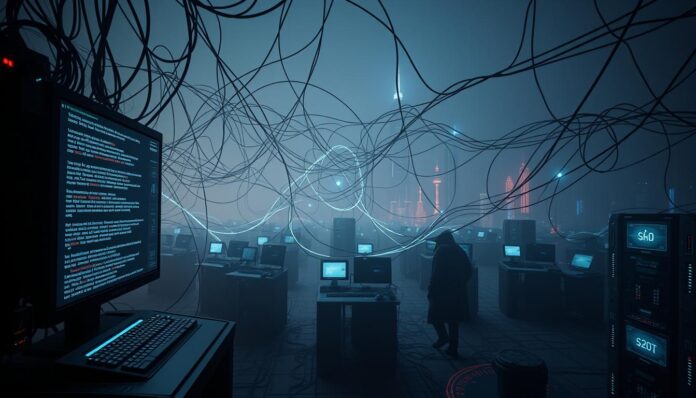As we approach 2025, the landscape of the Dark Web is evolving at a rapid pace, with Onion Links 2025 taking center stage in discussions surrounding online privacy and anonymity. This hidden corner of the Internet offers a double-edged sword: a platform for both activists seeking refuge and individuals engaging in illicit activities. Understanding the future of the Dark Web is crucial, especially as new technologies emerge, shaping how we navigate this clandestine network. In this article, we’ll explore the significance of maintaining anonymity and delve into what the coming years hold for users of Onion Links.
Understanding the Dark Web Landscape
The Dark Web is an intriguing part of the internet that many people find fascinating yet intimidating. It offers a haven for those seeking online anonymity, making it distinct from the more commonly known sections of the web. To truly grasp what the Dark Web is, it’s essential to understand its size, accessibility, and purpose.
What is the Dark Web?
The Dark Web represents a substantial segment of the internet, often cited as being 5,000 times larger than the Surface Web. Accessible solely through specialized browsers like Tor, it has gained a considerable following, with approximately 2.7 million daily users recorded in early 2023. This demonstrates a growing intrigue in clandestine online activities where users can maintain their privacy and escape surveillance.
Differentiating Between Dark Web, Deep Web, and Surface Web
Understanding the nuances between the Dark Web, Deep Web, and Surface Web is vital. The Surface Web refers to sites that anyone can find using standard search engines. The Deep Web encompasses unindexed pages like databases and secure information that can’t be accessed just by scrolling or searching. On the other hand, the Dark Web contains sites that require specific software for entry and promote a culture of online anonymity. This distinction helps organizations better assess the risks associated with various internet segments.

History and Evolution of the Dark Web
The history of the Dark Web is a fascinating journey marked by innovation, illicit activities, and ongoing clashes between anonymity and government actions. Its foundation lies in the concept of onion routing, developed in the mid-1990s by the U.S. Naval Research. This technology aimed to secure communications, providing the stepping stone for the eventual creation of the Tor Project in 2002. This development allowed users to browse the internet anonymously, shaping how the Dark Web operates today.
Origins of Onion Routing and Anonymity
The implementation of onion routing created a framework that prioritized user anonymity. By encrypting data in multiple layers, it became difficult for third parties to trace users’ activities. This innovation was essential to the emergence of the Dark Web, as it empowered individuals seeking hidden information or desiring privacy. This ongoing pursuit of anonymity has defined the virtual landscape where illicit activities often thrive.
The Rise of Online Marketplaces
The simplicity and reliability of onion routing spurred the development of online marketplaces on the Dark Web. Platforms like Silk Road emerged between 2011 and 2013, establishing a covert economy where illegal goods could be bought and sold with relative ease. This period marked a significant turning point in the history of the Dark Web, as online marketplaces flourished under the cloak of anonymity, attracting a variety of users and vendors alike.
Government Crackdowns and Their Impact
In response to the rapid proliferation of online marketplaces, government actions intensified. Operations such as Operation Onymous in 2014 sought to disrupt these illicit platforms by arresting key figures and dismantling operations. Despite these efforts, the Dark Web has proven resilient. Following shutdowns, new online marketplaces regularly emerge, demonstrating an ongoing cat-and-mouse dynamic between law enforcement and users. The history of the Dark Web reflects not just an evolution in technology, but also a complex interplay between digital freedom and government oversight.
Onion Links 2025: What to Expect
The landscape of the Dark Web is continuously evolving, driven by advancements in technology and shifting user preferences. With the Onion Links future in mind, users can anticipate a range of emerging technologies that will enhance both access and anonymity within this hidden online realm.
Emerging Technologies in Dark Web Browsing
As Dark Web technologies advance, new tools are emerging to facilitate safer and more anonymous browsing experiences. Innovations in security protocols, such as improved encryption and decentralized mesh networks, promise to redefine user interactions. These updates may not only enhance privacy but also streamline access to Onion Links, ensuring that users can navigate the Dark Web with greater efficacy and confidence.
The Role of Cryptocurrencies in Future Transactions
Cryptocurrency transactions play a crucial role in the operational dynamics of the Dark Web. While Bitcoin has been a staple for anonymous transactions, increasing interest in privacy-focused cryptocurrencies like Monero is noticeable. These currencies elevate user privacy levels and provide a shield against detection by authorities. As the Onion Links future unfolds, the integration of cryptocurrency will likely become even more prevalent, making it indispensable for those participating in the various marketplaces found online.
How to Access the Dark Web Safely
Engaging with the Dark Web necessitates cautious strategies to ensure a secure experience. Two essential tools play a pivotal role in this process: the Tor Browser and Virtual Private Networks (VPNs). Understanding how to utilize these tools can significantly enhance your ability to maintain privacy while exploring the more obscure parts of the internet.
Utilizing Tor and Other Dark Web Browsers
The Tor Browser remains the preferred method for accessing .onion domains, offering users the ability to navigate the Dark Web with a degree of anonymity. While Tor provides valuable protections, it is crucial to acknowledge that complete anonymity is not guaranteed. Users must remain vigilant and aware of the potential risks associated with browsing in this space. Knowing how to utilize the Tor Browser effectively contributes to safe access Dark Web, enabling users to explore with greater confidence.
Setting Up Secure Connections with VPNs
Incorporating VPN security alongside the Tor Browser is a productive way to enhance privacy levels. A VPN conceals your actual IP address, granting an additional layer of anonymity when navigating onion sites. This added protection is beneficial, particularly when dealing with sensitive information or engaging with unknown content. For those focused on safe access Dark Web, establishing a secure connection through a reliable VPN can significantly mitigate risks, allowing users to browse with improved peace of mind.
Legal Considerations Surrounding the Dark Web
The Dark Web presents a complex landscape filled with both opportunities and risks. Engaging in activities in this hidden part of the internet often involves navigating numerous Dark Web legal issues. While simply browsing the Dark Web does not violate laws, the line between legal and illegal becomes blurred when accessing certain materials or services. Understanding these gray areas is essential for anyone considering a foray into this realm.
Navigating the Legal Gray Areas
Users frequently encounter legal ambiguity when engaging with content on the Dark Web. Many activities sit within a legal gray area where the law does not provide clear guidelines. Downloading or sharing certain files might be legally questionable, especially when those materials involve illicit actions or services. The potential for legal repercussions increases considerably as individuals veer towards gray areas without proper knowledge or caution.
Implications of Engaging with Illicit Content
Engaging with illicit content can have severe consequences. Numerous high-profile takedowns of illegal marketplaces have resulted in arrests and serious charges for users. These incidents emphasize the legal ramifications tied to participating in the Dark Web’s underground economy. Understanding the potential illicit content implications is crucial, as law enforcement agencies continuously monitor this space to uphold legal standards. Users must remain informed and cautious to mitigate the risks associated with their online activities.
Security Risks Associated with the Dark Web
The Dark Web presents a myriad of security risks that can pose serious threats to unsuspecting users. Awareness of these dangers is crucial for maintaining safety while engaging in any online activities within this hidden realm. Individuals often become targets for cybercriminals who exploit the lack of oversight found in these anonymous spaces.
Common Threats and Vulnerabilities
Dark Web security risks manifest in various forms, including identity theft, phishing scams, and a range of cyber crimes specifically designed to catch naive users off guard. Cybercriminals frequently utilize forums and sophisticated tools to coordinate malicious activities that put personal data at risk. Awareness of these threats can significantly improve user safety.
Understanding Malware and Cybercrime
The environment of the Dark Web is often dominated by bad actors who spread different types of malware, such as ransomware and trojans. Users are typically unprepared for such attacks, making them vulnerable to cybercrime. Implementing proactive cybersecurity measures becomes vital for those who decide to navigate these concealed networks, aiming to safeguard their devices and personal information from harm.
Dark Web Marketplaces and Their Products
The landscape of Dark Web marketplaces continues to evolve, presenting a variety of illicit products as we approach 2025. Trends indicate that platforms specializing in illegal goods will remain robust, offering items such as stolen credit cards, hacking services, and various illegal drugs. Despite increased government scrutiny and law enforcement crackdowns, these marketplaces adapt, ensuring their sustained presence in the underground economy.
What’s Being Sold in 2025?
By 2025, Dark Web marketplaces are likely to maintain a diverse inventory of products aimed at various illicit needs. Items range from personal data, including Social Security numbers and bank account information, to tools for cybercriminals looking to exploit vulnerabilities. These platforms not only serve individual consumers but also cater to organized crime syndicates using them as a source for resources and information.
The Pricing Dynamic of Illegal Goods
The illegal goods pricing landscape is characterized by a wide variety of costs that reflect market demand and availability. According to insights drawn from the 2023 Dark Web Price Index, stolen accounts and personal information can command prices anywhere from $20 to several hundreds of dollars. Such fluctuations in pricing underscore the vibrant nature of this underground market and contribute to understanding the 2025 market trends among buyers and sellers alike.
Applications of the Dark Web in 2025
The Dark Web continues to evolve, serving various needs across multiple spheres. As both a haven for privacy-focused individuals and a tool for professionals, the applications of the Dark Web in 2025 highlight its critical role in activism and journalism, as well as various business uses.
Utilization by Activists and Whistleblowers
Activists and whistleblowers find the Dark Web an essential platform for communicating sensitive information without attracting unwanted attention. Tools like SecureDrop facilitate encrypted exchanges, allowing for confidential reporting without fear of government surveillance. This aspect of Dark Web applications has become increasingly important for those fighting for social change and transparency in their respective fields.
Use Cases for Businesses and Journalists
Businesses and journalists leverage the Dark Web for a multitude of purposes. Investigative journalism benefits from the ability to access stolen data and corporate espionage activities, providing insights into illegal operations. Furthermore, by monitoring discussions on the Dark Web, organizations can gauge public sentiment and potential threats to their data security. This integration demonstrates how Dark Web applications serve as vital resources for intelligence gathering and data protection within the realms of journalism and business.
Staying Safe While Browsing Onion Links
Ensuring Dark Web safety is crucial for anyone venturing into the complex and often unpredictable nature of onion links. Adopting effective OpSec measures can significantly reduce the risks associated with browsing the Dark Web. Users should prioritize strategies that protect their identity and data while navigating these murky waters.
Operational Security Measures
Implementing strong operational security measures is essential for safeguarding personal information. Disabling scripts in your browser prevents potential exploits that can compromise your device. Using anonymous payment methods and avoiding sharing any personal details can drastically enhance your safety while engaging with unknown entities. Regularly updating security software helps shield against vulnerabilities associated with the Dark Web environment.
Detecting and Avoiding Scams
Scam detection is vital for navigating the Dark Web safely. Individuals should remain vigilant for common signs of fraud, such as unrealistic promises or requests for sensitive information. Conducting thorough research before interacting with any seller or service can reveal more about their legitimacy. Trusting reviews from reliable sources can help determine whether a deal is too good to be true, emphasizing the need for caution in all dealings.
Conclusion
As we look towards the future of Onion Links, it becomes clear that the Dark Web is a complex blend of opportunities and challenges. The advancements in technology and the continuous evolution of online marketplaces paint a vivid picture of what 2025 may hold. While the anonymity provided by Onion Links can empower users—especially activists and whistleblowers—there is a persistent need to balance privacy with legality. Each decision made in the dark corners of the web carries significant weight.
This Dark Web summary highlights the importance of adopting safety strategies as individuals navigate these digital spaces. With the increasing sophistication of cyber threats and the ever-changing legal landscape, awareness of the implications of engaging with illicit content is essential. Users must remain vigilant about their online security as they traverse these uncharted waters.
Moving forward, it is crucial to recognize the potential benefits alongside the risks of the Dark Web. As we embrace the changing dynamics, improving cybersecurity measures will be a priority for users and stakeholders alike. A proactive approach to understanding the legal considerations and safety measures will serve everyone well as we collectively face the challenges ahead in this intriguing and often misunderstood realm of the internet.



